Examples of writing
GOLD RING FROM CAPUA (4th - 3rd centuries B.C.) - Alphabet of Etruscan Origin
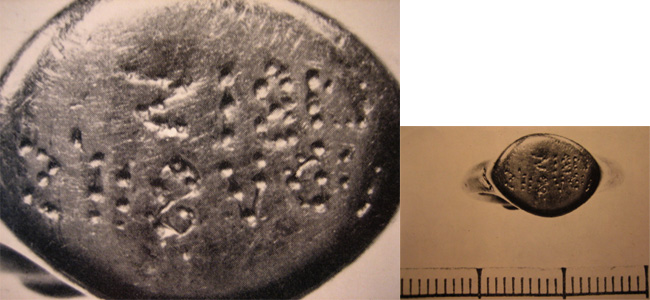
Transcription:
VIBIS
URUFIIS
EXAMPLE OF INSCRIPTION ON GOLD. Golden ring weighing 7.56 g found on 5 March 1873 in a place called Tirone, now in the town of S. Prisco, in the territory of ancient Capua, and at present kept in Paris in the Cabinet des Médailles. The inscription in on two lines both left-right. The letters, 0.15-0.2 cm high, are executed in points in a firm and clear way because previously outlined with a light line. The carving is too shallow for the ring to have been used as a seal (assumed by Conway, but rejected by Lejeune).
IOVILA OPISTHOGRAPH IN TERRACOTTA FROM CAPUA (4th - 3rd centuries B.C.)
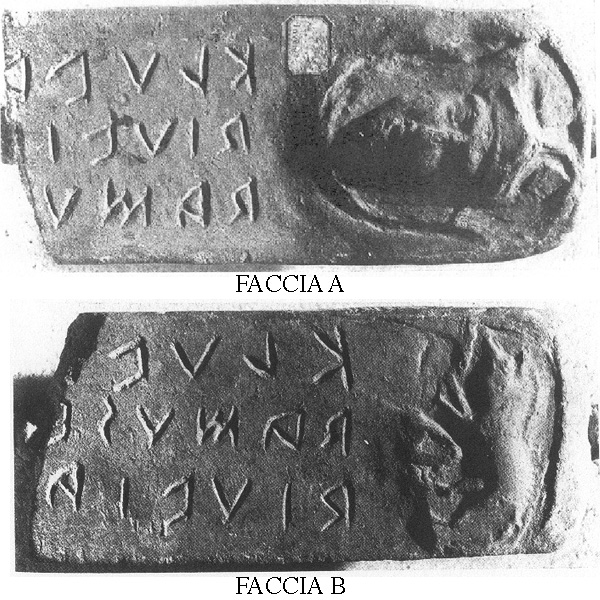
Source: Foto Museo Archeologico Nazionale di Napoli
Transcription Face A
KLUVA[.....]
DIUVIA[…]
DAMUSE[......]
Transcription Face B
KLUVA[.....]
DAMUSE[..]
DIUVIA [......]
EXAMPLE OF WRITING ON TERRACOTTA - ALPHABET OF ETRUSCAN ORIGIN. This document is an iovila opisthograph in terracotta found in S. Maria C.V. (ancient Capua - CE) in 1853 probably, in a place called Patturelli and now kept in the Archaeological Museum in Naples. Note the inversion of the second and third lines which distinguishes face A from face B. It speaks about the family Clovatii which probably offers public banquets during giovie, presumably feasts in honor of Jove.
IOVILA IN TUFF FROM CAPUA (3rd century B.C.)-ALPHABET OF ETRUSCAN ORIGIN
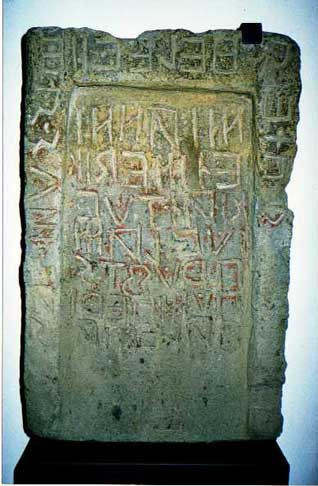
Source:
http://www.google.it/images?hl=it&client=firefox-a&hs=ani&rls=org.mozilla:it:official&channel=s&q=iovile+foto&um=1&ie=UTF-8&source=univ&ei=2-8ATYCnAdO08QOvo5WcCA&sa=X&oi=image_result_group&ct=title&resnum=3&ved=0CEMQsAQwAg&biw=1339&bih=562
Transcription:
S[E]PÍEÍS .
HELEVIIE
ÍS . SÚM MI . ANNI
IEÍ. MEDIK
KIAÍ . TÚV .
IÚVILAM 7PRÚFTS .
PÚMPERIA
FALENIAS
EXAMPLE OF WRITING ON TUFF - ALPHABET OF ETRUSCAN ORIGIN. This document is an iovila in tuff which is part of a couple of stele found in S. Maria C.V. (ancient Capua - CE) in 1887, probably, in a place called Patturelli. Now this find is kept in the Archaeological Museum of ancient Capua. The contents of these two tuffs are about the approval of the iovile (in particular see that of Sepio Elevio) in front of public officials (in the text considered, this official is represented by Minio Annio) made during Pomperie falenie, which were most likely feasts that took place in the month of Faleno. As regards the epigraphy, note that the onomastic formula sepíeís heleviieís is characterized by adding the verb be (súm) and this is an exception in the formulary of iovile. The short verbal form prúfts = prúfattens, referable to the magistrates, indicates the “bureaucratic” moment of making something sacred, probably, which was the task of the priest.
TABLE OF AGNONE (mid 3rd century B.C.)-ALPHABET OF ETRUSCAN ORIGIN
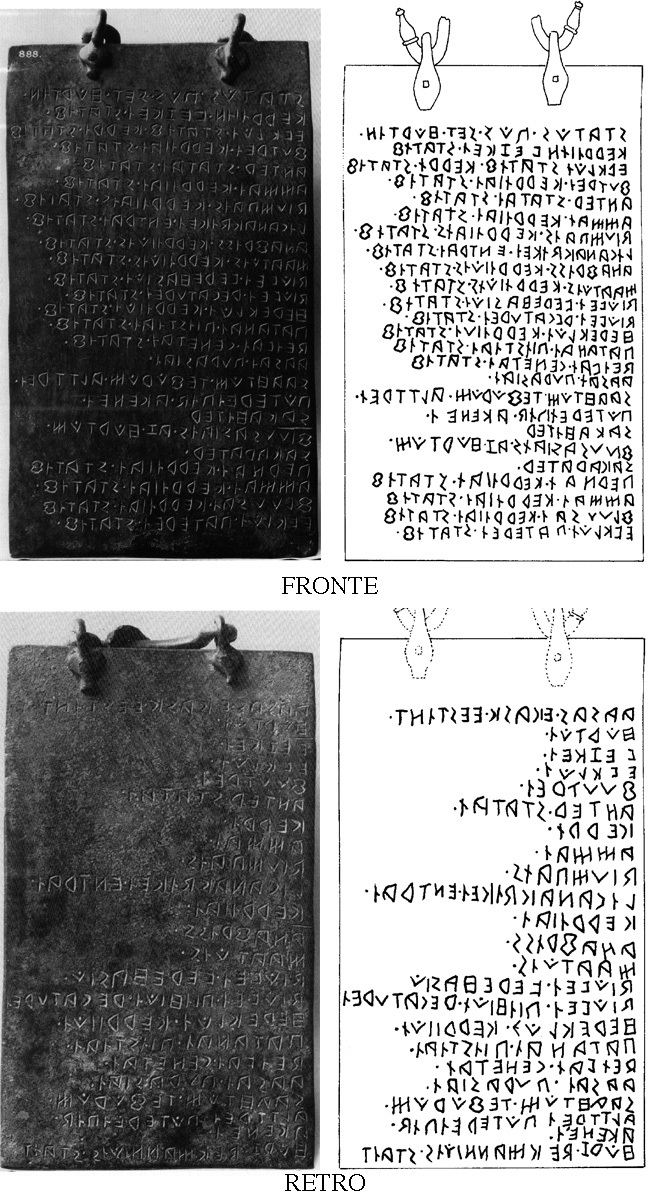
Source: Foto British Museum di Londra
Transcription front:
STATÚS PÚS SET HÚRTÍN
KERÍIÍN VEZKEÍ STATÍF
EVKLÚI STATÍF KERRÍ STATÍF
FUTREÍ KERRÍIAÍ STATÍF
ANTER STATAÍ STATÍF
ÍAMMAÍ KERRÍIAI STATÍF
DIUMPAÍS KERRÍIAÍS STATÍF
LÍGANAKDÍKEÍ ENTRAÍ STATÍF
ANAFRÍSS KERRÍIÚÍS STATÍF
MAATÚÍS KERRÍIÚÍS STATÍF
DIÚVEÍ VEREHASIÚÍ STATÍF
DIÚVEÍ REGATUREÍ STATÍF
HEREKLÚÍ KERRÍIÚÍ STATÍF
PATANAÍ PIÍSTÍAÍ STATÍF
DEÍVAÍ GENETAÍ STATÍF
AASAÍ PURASIAÍ
SAAHTÚM TEFÚRÚM ALTTREÍ
PÚTEREÍPÍD AKENEÍ
SAKAHÍTER
FIUUSASIAÍS AZ HÚRTÚM
SAKARATER
PERNAÍ KERRÍIAÍ STATÍF
AMMAÍ KERRÍIAÍ STATÍF
FLUUSAÍ KERRÍIAÍ STATÍF
EVKLÚÍ PATEREÍ STATÍF
Transcription back:
AASAS EKAKS EESTÍNT
HÚRTÚÍ
VEZKEÍ
EVKLÚÍ
FUUTREÍ
ANTER STATAÍ
KERRÍ
AMMAÍ
DIUMPAÍS
LÍGANAKDÍKEÍ ENTRAÍ
KERRÍIAÍ
ANAFRÍSS
MAATÚÍS
DIÚVEÍ VEREHASIÚ
DIÚVEÍ PIÍHIÚÍ REGATUREÍ
HEREKLÚÍ KERRIIÚÍ
PATANAÍ PIÍSTÍAÍ
DEÍVAÍ GENETAÍ
AASAÍ PURASIAÍ
SAAHTÚM TEFÚRÚM
ALTTREÍ PÚTEREÍPÍD
AKENEÍ
HÚRZ DEKMANNIÚÍS STAÍT
EXAMPLE OF WRITING ON BRONZE - ALPHABET OF ETRUSCAN ORIGIN. Table in bronze (28 x 16.5 cm) opisthograph found in 1848, not in its original position, in a place known as “Fonte del Romito” near Agnone (Is) and now in the British Museum in London. The text on side A corresponds to and completes what is said on side B, providing very useful information for the interpretation. Furthermore, side A has an epigraphic field greater than side B and it is possible to find a small line of separation after line 19 on side A and after lines 2 and 11 on side B. The diacritical marks í and ú introduced in a period later than the formation of the basic alphabet are also of epigraphic importance. There are several interpretations of the contents of the text, but it seems plausible that the table, although not a ritual text, indicates a series of cults and rites to do in the garden (hurz) for some gods in dative (Euclo, Amma, Ercole, Cerere, Diva genita) that are affected when speaking of the altars where the sacrifice and/or the offer is made. They do not say, however, exactly when and how this happens. A particular sacrifice seems to be the one made in the aasa purasia.
PAINTED TOMB INSCRIPTION FROM CAPUA (just after mid-3rd century B.C.) - ALPHABET OF ETRUSCAN ORIGIN
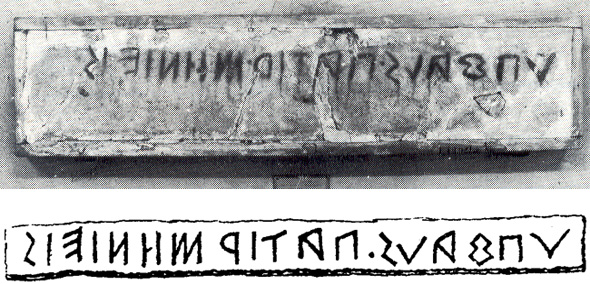
Source: Foto Museo Archeologico Nazionale di Napoli
Trascription
ÚPFALS. PATIR. MIÍNIEIS
EXAMPLE OF PAINTED INSCRIPTION - ALPHABET OF ETRUSCAN ORIGIN. The inscription, found in 1867 in an uncertain location of S. Maria Capua Vetere , was painted in red on a wall of the left cell of a tomb with painted rooms (from which it was removed when found) near the funeral bed at the end of the tomb. È una tipica iscrizione di possesso in cui si nota il nome Úpfals seguito dall'appellativo di padre (patir) e dal patronimico in genitivo (Miínieis). The writing from right to left and the presence of the marks í and ú are of epigraphic importance.
DEDICATION ON ALTAR FROM TEANO (second half 3rd-beginning 2nd centuries B.C.)-ALPHABET OF ETRUSCAN ORIGIN
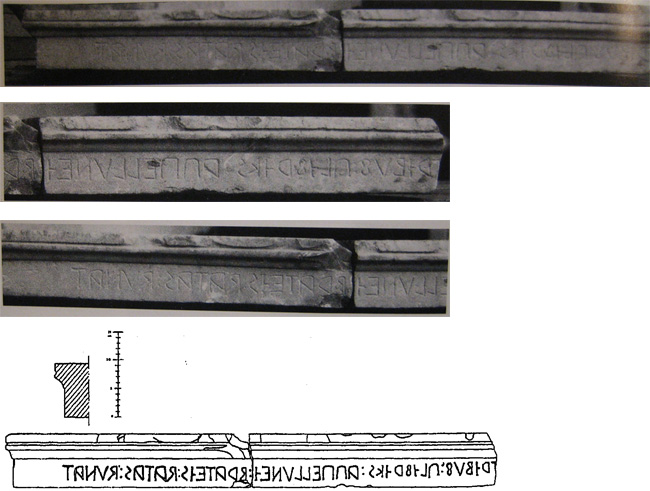
Source: Foto Museo Archeologico di Teano
Trascription:
[-?-]TRÍBUF: PLÍFRÍKS: APPELLUNEÍ: BRATEÍS: DATAS: DUNAT
EXAMPLE OF INSCRIPTION ON LIMESTONE - ALPHABET OF ETRUSCAN ORIGIN. Altar table in limestone (95.2 cm long and 9.2 cm high) with molded frame and inscription. The find, like the altar table from Ercolano with an Oscan dedication to Venere Ericina (kept in Naples, Archaeological Museum), is broken into two pieces which fit together and is lacking the initial part. It was found in October 1998 during the excavations near the theatre of Teanum Sidicinum (now Teano in province of Caserta) and comes from the fall of the structures of the scaenae frons of the Severan age where, probably, it had been reused. Now it is kept in the Archaeological Museum of Teano. It is a dedication to Apollo that, besides confirming the presence of Apollo in the Oscan pantheon, with the mention of the tribunal of plebs (if tríbuf: plífríks is to be interpreted like tribunus plebis), indicates the assimilation of Roman institutions in Teano as early as the 3rd century B.C., and also the influence of the nearby Roman colonies of Cales and Suessa. Epigraphically of interest is that the inscription is under the molded frame with ductus from right to left and with well executed signs 2.1-2.2 cm high. The opening part of the text, probably containing the name of a person, is missing. We must note the presence of diacritic letters (í) and the dividing mark between the words formed of two points placed one on top of the other that was generally used prior to the 2nd century B.C.
LIMESTONE SLAB FROM ROSSANO DI VAGLIO - ALPHABET OF GREEK ORIGIN
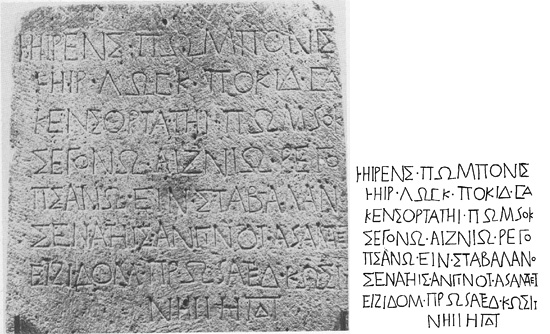
Source: Foto Museo Archeologico Nazionale di Potenza
Trascription:
hηιρενς. πωμπονις
hηιρ. λωfκ. Ποικιδ. fα
κενσορ. τα. Τηι. πωμfοκ
σεγονω. αιζνιω. ρεγο
πσανω. ειν. σταβαλανο
σενατηις. ανγινοτ. αfαματετ
ειζιδομ. πρωfατεδ. κωσιτ
ΝΗΙΙΗΙΙΔ
ESEMPIO DI ISCRIZIONE SU CALCARE - ALFABETO A BASE GRECA. L’iscrizione, redatta su una lastra calcarea (h. cm. 75, largh. cm. 65; spessore cm. 22) rinvenuta nel 1971 nei pressi del santuario dedicato alla dea Mefitis, si presenta ben conservata, ma il ductus è alquanto irregolare. A livello epigrafico si notano delle legature e l’uso del segno S per indicare la /f/. Per quel che concerne il contenuto siamo dinanzi ad un Heirenno Pomponio figlio di un Heirenno Lucio Puccidio che, durante la censura, definita probabilmente πωμfοκ (che alcuni interpretano come quinquennale), dopo aver sentito l’opinione del senato (σενατηις. ανγινοτ), prima ordinò che venissero fabbricate ed erette delle statue bronzee dedicate a dei sovrani e, successivamente le approvò. Infine si indica anche il costo sostenuto pari a 350 nummi (κωσιτ ΝΗΙΙΗΙΙΔ).
BRONZE HELMET FROM METAPONTO (4th century BC) - ALPHABET OF GREEK ORIGIN
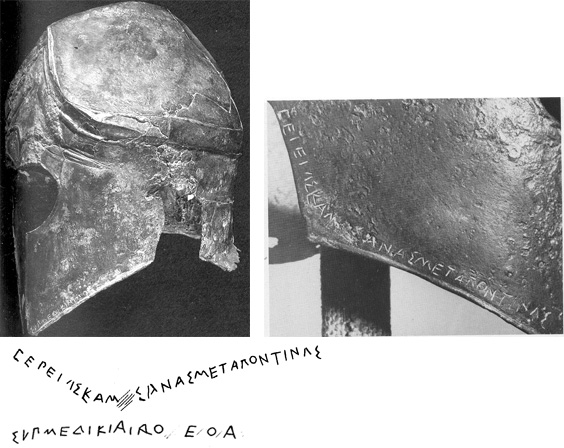
Source: Foto Museo Poldi Pezzoli di Milano
Transcription:
Ïœερειαςκαμ[]σαναςμεταποντινας
συπμεδικιαιαο[]ε[]οα
EXAMPLE OF INSCRIPTION ON BRONZE - ALPHABET OF GREEK ORIGIN. Bronze helmet of Greek type discovered in unknown circumstances in the 19th century in Metaponto. The inscription is on the lower borders of the two cheekpieces and presents some lacunas. The ductus is left to right and no punctuation marks are noted. As regards the contents, besides a mention to vereia (Ïœερειας) and to meddicia it is not possible to say much more, although some scholars, referring to the adjective μεταποντινας to the word [α] σανας and reading in it the name of Athena, see in it a dedication to Athena of Metaponto.
DEDICATION TO DIOVA DIOMANA (3rd - 2nd centuries BC) - ALPHABET OF GREEK ORIGIN
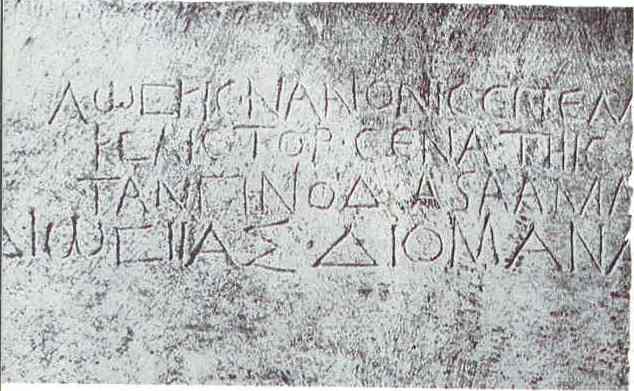
Source: Foto Museo Archeologico Nazionale di Potenza
Transcription:
λωfκισ. νανονισ. σπε[μ
κfαιστορ. σενατηισ
τανγινοδ. αfααμα[
διωfιιασ. διομανα[
EXAMPLE OF INSCRIPTIONS ON STONE - ALPHABET OF GREEK ORIGIN. Inscripted slab found near the Lucan sanctuary of Rossano di Vaglio. The inscription has a regular form and epigraphically uses both the mark [ and S to indicate the /f/. As for the contents, it contains an official dedication made by the quaestor Lucius Nanonio as ordered by the Senate (σενατηις τανγινοδ) to the goddess Diovia Diomana.
TABULA BANTINA (OSCAN PART - FRAGMENT ADAMESTEANU - beginning of 1st century BC) - ALPHABET OF LATIN ORIGIN
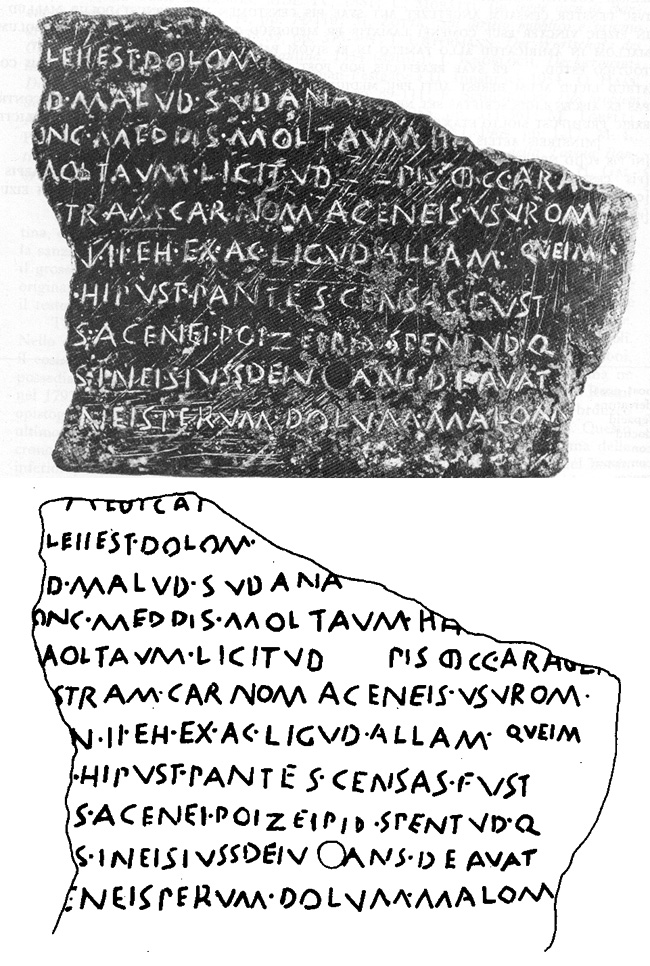
Source: Foto Museo Archeologico Nazionale di Potenza
Transcription:
]LEIIST DOLOM[
]D MALUD SUDANA [
]ONC MEDDIS MOLTAUM H [
]MOLTAUM LICITUD PIS ↀ CC ARA [
]STRAM CARNOM ACENEIS USUROM
]N II EH EX AC LIGUD ALLAM
]HIPUST PANTES CENSAS FUST
]S ACENEI POIZEIPID SPENTUD Q
]S IN EISIUSS DEIV ANS DEAVAT
]ENEIS PERUM DOLUM MALOM
EXAMPLE OF INSCRIPTION ON BRONZE - ALPHABET OF LATIN ORIGIN. Fragment belonging to a table in bronze (so-called Tabula Bantina) opisthograph with a Latin inscription on one side and an Oscan inscription using the Latin alphabet on the other. This fragment, found in 1967 and known to belong to the Tabula bantina from Adamesteanu, was important for the dating of the text in Latin and Oscan. In fact, it has a hole for the nail from which it would have been hung which the Oscan engraver took into account when impressing the word deivans. For this reason the Oscan text is believed to be later than the Latin; if the Latin inscription is commonly dated back to 100 B.C., the Oscan inscription probably can be dated back to 80-70 B.C. Epigraphically we can note both the presence of the mark G and the mark Q. The ductus is left to right and quite regular with the only irregularity linked to the presence of the hole. As regards the contents, instead, considering that there are some problems concerning the Latin part as well, the Oscan inscription seems to be about the order of the town in a new situation which is difficult to define, and the presence of words borrowed from Latin concerning the magistracy is important. In particular, the Adamesteanu fragment contains some words never used before and new inflections of already known words as well as others difficult to explain. But on the whole it seems to refer to a fine of 1200 pounds in silver, to the census and to an oath.
OINOCHOE IN BUCCHERO FROM NUCERIA (second half 6th century B.C.) - EXAMPLE OF THE PERIOD OF THE ORIGINAL FORMATION OF THE OSCAN WRITING SYSTEMS ("PROTOCAMPANO" OR "PALEOITALICO" OR "NUCERINO†ALPHABET)
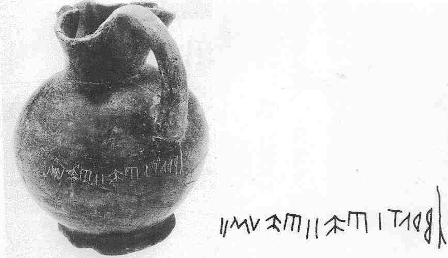
Source: Tesi di dottorato di Alessia Ventriglia
Trascription:
// BRUTIES // ESUM //
PLE OF INSCRIPTION ON BUCCHERO. Oinochoe in bucchero, globular figure, ring base, trefoil mouth, 22 cm high. It was found in 1964 in Nocera Superiore – Pareti, within tomb 32 together with other burial objects among which a bowl with a Greek inscription; it is kept at the Antiquarium in Nocera Superiore. The inscription, clearly of ownership, has a continuous scriptio 12.5 cm long on the vase, and presents some typical peculiarity of this alphabet (also called "Nucerino" from the place where it was developed). These include the so-called "sapling sign" to represent a sibilant consonant and the 90° rotation of letters from the normal right-left ductus. It is also important to note the presence of marks like two "i" parallel or longer than the inscription, as word separators.
LITTLE CUP IN BUCCHERO FROM SORRENTO (end 6th-beginning 5th centuries B.C.) - Example of the period of the original formation of the Oscan writing systems ("protocampano"or "paleoitalico"or "Nucerino" alphabet)
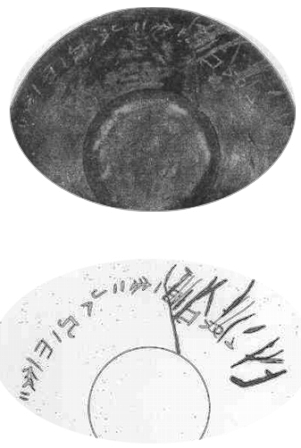
Source: Tesi di dottorato di Alessia Ventriglia
Transcription:
RUFIEIS PAFIEIS oppure URUFIEIS PAFIEIS
EXAMPLE OF INSCRIPTION ON BUCCHERO. Small cup of the Albore Livadi 15A type, the sizes of which are: h. 4.5 cm, max. diam. 13.1cm, base diam. 5.6 cm. It was probably found in an ancient necropolis in Sorrento and now it is kept in the Fluss Collection in Sorrento. There are two inscriptions; the one written in the "Nucerino alphabet" is the longest and presents 19 marks of different height in a continuous scriptio with a ductus from right to left for about 13.5 cm. The inscription, clearly of ownership, presents some uncertainty in the reading of the first mark, which may be a punctuation mark, or demarcation or a "u". Also noteworthy are the typical presence of the "sapling sign”, the rotation of the letters, the presence of word separators and a mark like the Oscan mark for "v" [w] which has two apices and must be read like the mark "f" [f].
OINOCHOE IN BUCCHERO FROM VICO EQUENSE (2nd half 6th century B.C.) - Example of the period of the original formation of the Oscan writing systems ("protocampano"or "paleoitalico"or "Nucerino†alphabet)
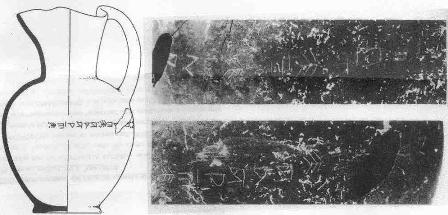
Source: Tesi di dottorato di Alessia Ventriglia
Transcription:
IEVIES // ESUM : P[-]CES : ADARIES
EXAMPLE OF INSCRIPTION ON BUCCHERO. Oinochoe bucchero with trefoil mouth, ovoid form, cord handle and disc foot. The sizes of this object are: max. h. 30.8 cm; max. width 19.1 cm. The oinochoe was found in a necropolis discovered in Vico Equense in Via Nicotera and is now kept in the Antiquarium in Vico Equense. The inscription, made after baking, is under the handle in the largest part of the vase and it was written in a firm and elegant way, in continuous scriptio and from right to left. To be noted the typical presence of the "sapling sign”, the 90° rotation towards right of the letters and the presence of word separators.
ATTIC KYLIX IN BLACK PAINT FROM STABIAE (1st half 5th century B.C.) - Example of the period of transition towards the Oscan alphabet.

Source: Mia tesi di dottorato
Transcription:
AHTÍCA SUM
EXAMPLE OF INSCRIPTION ON POTTERY. Attic Kylix in black paint of type 1. The object, kept in the Antiquarium in Castellammare di Stabia, presents an inscription going right to left in a probably Etruscan alphabet, but in which can be seen the irregular presence of an i with a side appendix recalling the diacritic i of the Oscan alphabet of Etruscan origin.
"AMPHORA OF CHIOS" FROM VICO EQUENSE (5th or 4th century BC) - Example of the period of transition towards the Oscan alphabet
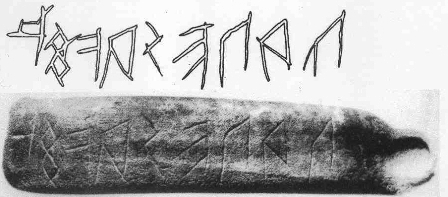
Source: Tesi di dottorato di Alessia Ventriglia
Transcription:
PAPE SAFVÍ
EXAMPLE OF INSCRIPTION ON TERRACOTTA. Amphora of Chios, sizes: h. 5.6 cm; border diameter 15.5 cm. The object, found in 1877 in Vico Equense near Sorrento and now kept in the Archaeological Museum of Naples, presents an inscription, made on the handle after baking, from right to left, with letters 2.5 – 3.5 cm high. The alphabet seems to be Etruscan, but there is the anomalous presence of an i with a side appendix recalling the diacritic i of the Oscan alphabet of Etruscan origin. Furthermore, although the alphabet seems to be Etruscan, the name in the inscription seems, instead, to have a typical Italic origin. Finally, on the neck of that amphora there is also a star carved after baking.